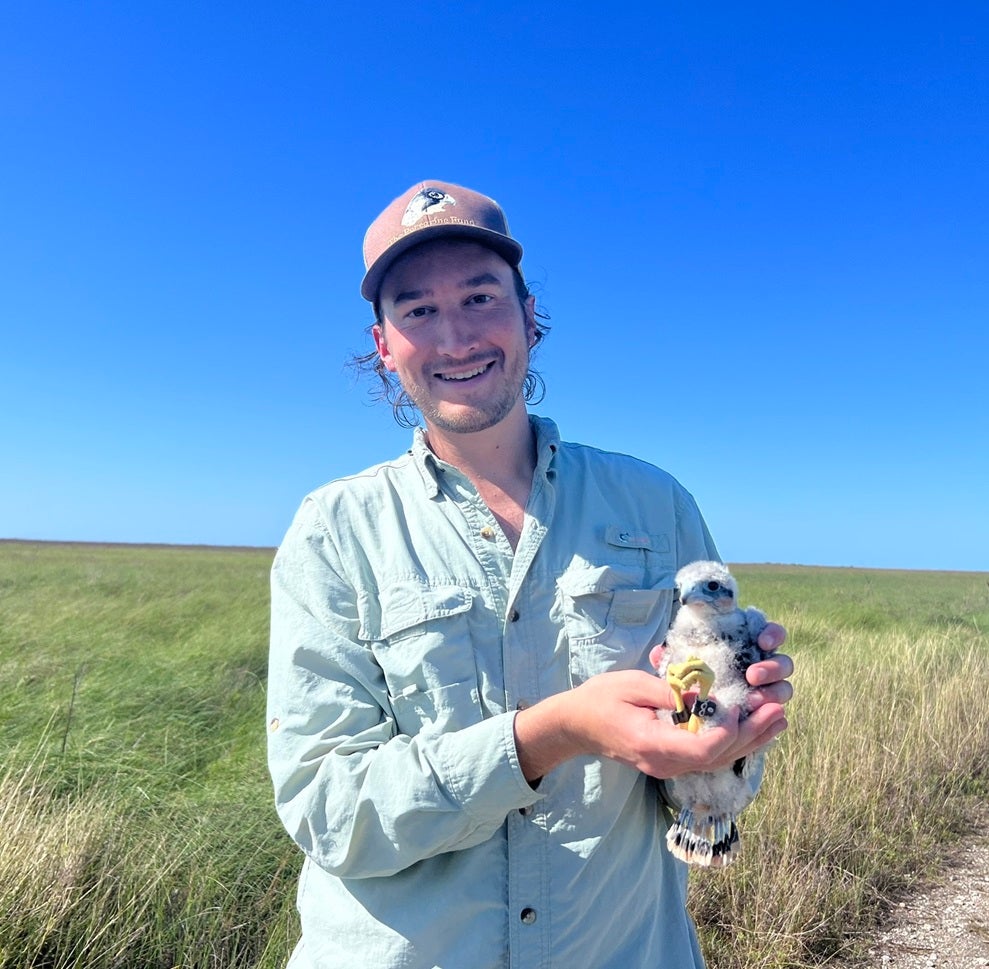
Boise State University MS Raptor Biology student David Bontrager defended his thesis, “Distribution of Great Horned Owls (Bubo virginianus) Near Breeding Grounds of the Reintroduced Northern Aplomado Falcon (Falco femoralis septentrionalis) at Laguna Atascosa National Wildlife Refuge in Coastal South Texas” midday on June 19, 2024. David Bontrager’s main advisor is Jen Cruz (Boise State University Raptor Research Center, Biological Sciences), and his committee also includes Jennifer McCabe (The Peregrine Fund) and Trevor Caughlin (Boise State University Biological Sciences).
ABSTRACT
Habitat change is the leading cause of species extinctions and declines worldwide. In addition to species losses, habitat changes can also alter species behavior, diet, and the way they interact with other species. Less than 1 % of coastal grasslands and prairies in Texas remain intact as a result of agriculture, urbanization, and woody plant encroachment. These habitat losses had bottom-up consequences, including the extirpations of multiple species that inhabited these ecosystems, such as the Northern Aplomado Falcon (Falco femoralis septentrionalis), Attwater’s Prairie Chicken (Tympnuchus cupido attwateri), and Pronghorn (Antilocapra americana). Further, areas with woody plant encroachment in the region may be benefiting Great Horned Owls (Bubo virginianus), a generalist predator that is known to predate fledgling Northern Aplomado Falcons. After its extirpation in 1952, the Northern Aplomado Falcon was reintroduced to the U.S. beginning in 1977, and a small, isolated breeding population currently persists along the South Texas coast. Here, we aimed to 1) compare separate single-method occupancy models against an integrated approach that combines two survey methods in a single model to make the most informed inference about Great Horned Owl distribution, and 2) determine the distribution of Great Horned Owls in relation to vegetation cover. During the winters of 2022 and 2023, we used callback surveys and autonomous recordings units at 65 survey points to determine the distribution of Great Horned Owls on Laguna Atascosa National Wildlife Refuge, an important breeding area in the U.S. for Northern Aplomado Falcons. The three occupancy models estimated owl distribution by relating owl occupancy to crop, grass, shrub, aquatic vegetation, and tall vegetation (> 3 m) cover, while accounting for imperfect detection. We found that the callback surveys provided more conservative estimates of owl occupancy and reliable relationships with habitat and therefore chose the callback-only model for further inference. Results from this model suggested that Great Horned Owls occupied areas with tall vegetation cover above 5%. Similarly, owls were more likely to occupy areas with shrub cover above 30%. Overall, Great Horned Owl distribution was widespread within the refuge, and nest cameras confirmed that owls come in close contact with nesting Northern Aplomado Falcons, with 4 of 10 cameras capturing owls perched or consuming prey on Northern Aplomado Falcon artificial nest structures. Thus, results suggest that increases in woody plant encroachment likely benefited Great Horned Owls and that owls pose a major threat not only to adult falcons, but especially naïve, newly fledged young. Our findings can be used to inform where habitat restoration efforts should occur. We recommend prioritizing removal of woody plant encroachment in areas of high owl occupancy and near falcon nests to reduce the risk of predation. Furthermore, future Northern Aplomado Falcon release efforts should consider owl distribution and the level of tall vegetation and shrub cover when selecting release sites in order to maximize their survival. Reintroduction efforts of other species would also benefit from assessing how habitat changes may impact species interactions when returning a species to an altered landscape.